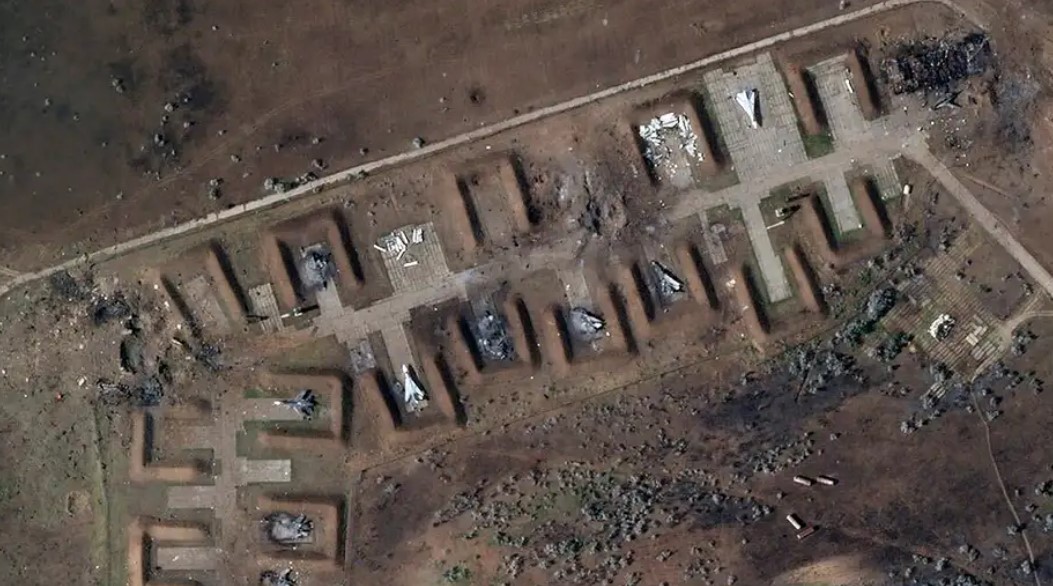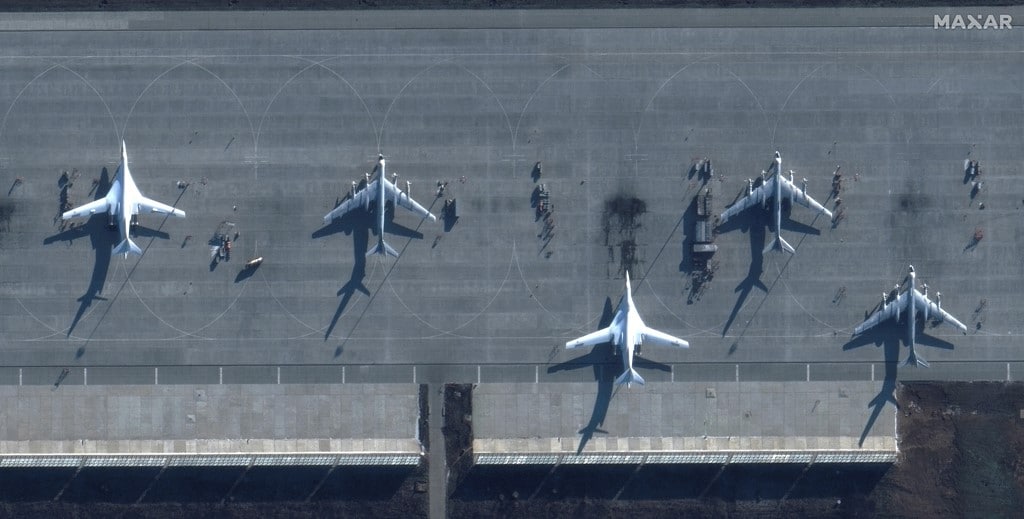Platforms for attacks: How Russia uses airfields for war and Ukraine's countering options
 Photo: Ukraine attacked the Engels airfield several times in the Russian rear (Russian media)
Photo: Ukraine attacked the Engels airfield several times in the Russian rear (Russian media)
Last week, Ukrainian special services attacked the Engels airfield near Saratov (Russian Federation). It is one of the dozens of military airfields Russians use to launch aviation for strikes but far from the only one targeted by Ukraine in the past two years.
For more information about the airfields Russia uses in the war and how Ukraine launches counterstrikes, read the article below.
Sources: Wikipedia, Military portal, Army INFORM, and comments from the military and political expert of the Information Resistance Group Oleksandr Kovalenko.
Contents
- Airfields in Ukraine's mainland
- Airfields in occupied Crimea
- Airfields in Belarus
- Airfields in Russia

Photo: Map of airfields Russia uses in the war against Ukraine (RBC-Ukraine infographics)
Airfields in Ukraine's mainland
Russians actively use airfields in the occupied mainland, not always deploying aviation. For example, in December 2022, the Defense Forces struck a field aerodrome near Kakhovka in the Kherson region. At that time, up to 200 occupiers were killed or injured, and up to 20 units of enemy equipment were destroyed.
In November of the same year, the Armed Forces targeted the Chaplynka airfield during the operation to liberate the right-bank Kherson region. After that, the occupiers urgently relocated their aviation. As explained by the then Air Force spokesperson Yurii Ihnat, the airfield was used to support ground forces with Ka-52 helicopters and Su-25 attack aircraft. Chaplynka came under Ukrainian artillery fire, so the base was moved deeper into the rear. Partly to the village of Strilkove on the Arabat Spit and to Berdyansk (Zaporizhzhia region).
The Russians use the Melitopol airfield to station helicopters, other equipment, ammunition depots, and personnel. That's why news about bavovna (explosions ironically - ed.) occasionally comes from there, as Mayor Ivan Fedorov said last fall. Melitopol is about 70 km away from the front line, so, likely, the airfield is also attacked using HIMARS systems.
Airfields in the occupied Berdyansk and Luhansk are about 90 km from the front line. On the night of October 17, 2023, Ukrainian forces used long-range ATACMS missiles for the first time as part of Operation DRAGONFLY. According to OSINT investigators, the strikes destroyed or damaged over 20 helicopters. Periodically, explosions in the area of the airfield are reported by Berdyansk residents.
 Photo: After the ATACMS attack on the airfield near Luhansk (Schemes/Planet Labs)
Photo: After the ATACMS attack on the airfield near Luhansk (Schemes/Planet Labs)
"It is necessary to strike at airfields because tactical aviation, and attack, transport helicopters, and so on are based there. The Russians at one time became so brazen that they used aviation on the occupied territories not far from the front line. Everyone remembers the successful ATACMS strikes on airfields in Berdyansk and Luhansk, where a large number of helicopters were destroyed at once. This is important because helicopters are one of the advancing elements of the Russian occupiers," Oleksandr Kovalenko, a military and political expert for the Information Resistance Group, explained to RBC-Ukraine.
Besides, command posts and control points are located at airfields.
"It's important to target them because it undermines the overall control system. Ammunition depotsб fuel and lubricants are also located there. Therefore, their total destruction is essential," emphasized the expert.
Airfields in occupied Crimea
The same system applies to airfields on the peninsula involving depots, communication nodes, and control points, explains Kovalenko. The difference is that not only attack helicopters like Ka-52 and Mi-28 are stationed in Crimea but mainly tactical combat aircraft like MiG-31, MiG-29, Su-27, Su-30, of various modifications.
The occupiers use at least five Crimean airfields for aviation, as previously stated by the Air Force, allowing them to control the sky over the Ukrainian waters of the Black and Azov Seas, over coastal areas, and to attack southern regions of Ukraine. For this purpose, for example, Su-30SM fighters, Su-34 bombers, and Su-25 attack aircraft launch a wide range of bombs and missiles. With the glide bombs, strikes are delivered from a distance of 50-70 km, without entering the Ukrainian air defense zone.
One of the key airfields is located near Saky. It was ready for immediate combat actions even before the full-scale invasion. Before the occupation, it was a base of the Ukrainian Navy, now it houses the Russian 43rd Fighter Aviation Regiment with Su-30SM, Su-33, and Su-24M aircraft.
In September, Ukrainian forces heavily attacked it with drones and Neptune missiles. At that time, there were at least 12 combat aircraft, Pantsir missile systems, and a drone operator training base Mojaher in Saky. In January 2024, Ukraine's Defense Intelligence conducted a joint operation with the Air Force, striking at radar positions. It was also reported about the destruction of a control point.
 Photo: Aftermath of the strike on the Saky airfield (Planet Labs)
Photo: Aftermath of the strike on the Saky airfield (Planet Labs)
The second major aerodrome, Belbek, is located north of Sevastopol. It houses Su-27, Su-27SM, Su-30M2, and Su-27M aircraft. It was reported that after reconstruction in 2020, it could supposedly accommodate strategic bombers Tu-22M3, Tu-160, and Tu-95MS armed with missiles with a range of over 5000 km.
During the full-scale war, Ukraine attacked Belbek at least three times. The latest strike occurred on January 31 using Storm Shadow/SCALP aviation missiles. As a result, three planes were damaged, with reports of hits on radars and communication points.
An important logistical hub became the Dzhankoy airfield, facilitating the supply of occupiers to the Kherson and Zaporizhzhia regions. Its runway allows heavy transport planes to land, and it also houses attack helicopters. Explosions rock around Dzhankoy from time to time.
The Hvardiiske airfield is an airbase north of Simferopol, from which combat aviation takes off. It hosts two squadrons of 12 Su-24M frontline bombers and 12 Su-25SM attack aircraft each. In early March, according to Russian media, two unidentified missiles damaged the runway at the aerodrome, resulting in injuries. Crimea has a total of 15 airfields, but most are not used for aviation purposes.
The fewer planes Russians have after such strikes, the better for Ukraine. These attacks aim to reduce the overall combat readiness of the occupiers and undermine their capabilities in supporting forces in the south. There is no mention of serious preparations for Crimea's de-occupation, unfortunately, as stated by Kovalenko.
"Each of these strikes is like a brick in the future bridge to liberating the peninsula. It's too early to talk about it, it won't happen soon. But we're moving towards it," he added.
Airfields in Belarus
In 2022, the Russian army engaged almost all Belarusian airfields for strikes against Ukraine. Aviation was deployed there even before the invasion under the guise of "exercises." Combat helicopters and planes were based at aerodromes in Lida, Baranovichi, Luninets, Dubrovitsa, and Zyabrovka.
Zyabrovka became a main base due to its convenient location. It is near Gomel, only 22 km from the Ukrainian border, and 90 km from Chernihiv. Explosions occurred there in August 2022. As reported by the monitoring project Belarusian Hajun, a batch of S-300/400 missiles was delivered there. However, according to the Belarusian Ministry of Defense, "one of the units of equipment exploded during a test run." Ukraine did not comment on this incident.
Russians have stopped using Belarusian airfields after the attack on Machulishchy. In February 2023, serious damage was inflicted on the A-50 long-range radar detection aircraft over sabotage. Two drones were used in the attack, and responsibility was claimed by the Association of Security Forces of Belarus (BYPOL), which includes Belarusian military personnel who oppose Lukashenko. Recently, the head of the SSU (Ukrainian Security Service), Vasyl Maliuk, announced the involvement of Ukrainian special services. According to him, the attack in Machulishchy disabled the A-50's radar system.
"They surgically targeted the antenna. The operational team of the service referred to it in their slang as a frying pan," he noted.
It was reported in the fall of last year that the Russian Federation had withdrawn nearly all its aircraft from Belarusian airfields. However, one cannot completely rule out their return, according to Oleksandr Kovalenko.
"Everything depends on the situation, on the goals set by the occupiers and their command. If there is a combat mission to influence northern Ukraine using tactical aviation, they may try to do so (return to Belarusian airfields - ed.). But now, not only drones pose a threat to them, as Northern Ukraine, Kyiv, and Kyiv region are protected by some of the best multi-layered air defense systems, including Patriot and SAMP-T, which can be classified as long-range surface-to-air missile systems. So, if necessary, their aviation can be reached even in Belarusian airspace," the expert noted.
Airfields in Russia
Ukraine has been targeting Russian airfields since the beginning of the full-scale war. On February 25, 2022, the Millerovo base in the Rostov region was attacked with a Tochka-U missile. At that time, it housed Su-30SM, Su-25 aircraft, and helicopters, and two aircraft were reported destroyed. In November of the same year, two drones again struck the airfield.
In March 2022, an explosion damaged an Il-76 transport aircraft at the Taganrog airfield (Rostov region), resembling a missile strike. In the summer of 2023, Tu-95 missile carriers and an A-50, which was under repair, were spotted at the same airfield. During one of the attacks, a missile was shot down shortly after takeoff. On March 9, 2024, as reported by RBC-Ukraine sources within intelligence agencies, drones finally reached this A-50.
In October 2022, two attack helicopters Ka-52 Alligator exploded at the Veretye base in the Pskov region, 600 km from the Ukrainian border. As clarified by Ukrainian intelligence, a Mi-28N helicopter was also destroyed. They were all booby-trapped. According to Radio Svoboda, saboteurs were at work, and many experts considered the incident one of the best intelligence diversions at that time.
On December 5, 2022, explosions rocked two rear airfields - Engels near Saratov and Dyagilevo near Ryazan. At Engels, two strategic Tu-95 bombers used for long-range missile launches against Ukraine were damaged, while at Dyagilevo, a Tu-22M3 bomber and a refueling aircraft were damaged. Later, Ukrainian intelligence reported that modified Soviet Tu-141 Strizh drones were used in the attack. Both airfields are hundreds of kilometers away from the Ukrainian border.
 Photo: Aftermath of the strike on Engels airfield, December 2022 (Maxar)
Photo: Aftermath of the strike on Engels airfield, December 2022 (Maxar)

